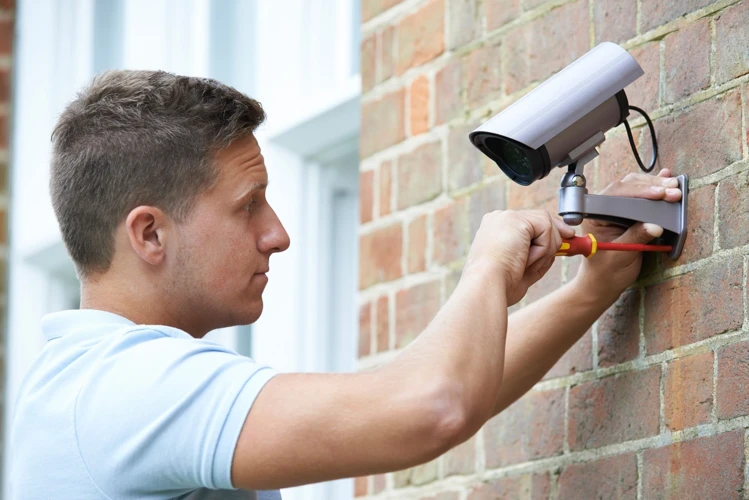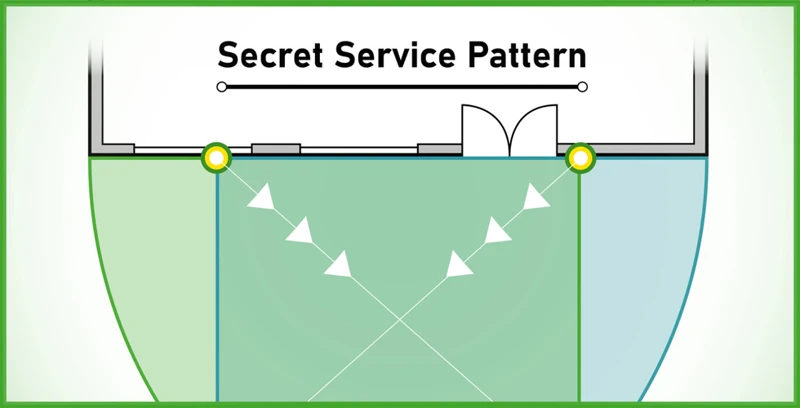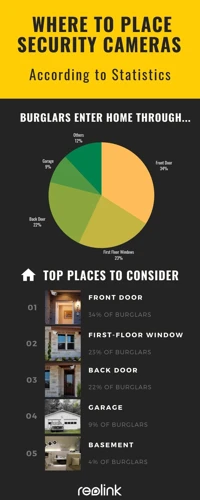Have you recently purchased outdoor surveillance cameras but aren’t getting the maximum coverage you expected? Do you wonder why your camera footage is not clear or why you are missing important details? Properly angling your outdoor surveillance cameras plays a crucial role in achieving optimal coverage and enhancing your home security. But where do you start? In this guide, we’ll discuss the importance of camera positioning, the best camera placement, and the ideal angle for outdoor surveillance cameras. We’ve also included additional tips to help you get the most out of your cameras. Keep reading to discover how to angle your outdoor surveillance cameras for maximum coverage.
Why Proper Angle Matters

As you start setting up your outdoor surveillance system, you may find yourself struggling with the best way to angle the cameras. You might wonder why proper angle matters and how it affects the quality of the footage. Choosing the right angle is crucial for maximizing the coverage of your outdoor surveillance cameras, ensuring that the entire area is covered and all crucial entry points are in view. In this section, we’ll delve deeper into the reasons behind the importance of camera positioning and how this aspect can affect the overall performance of your outdoor surveillance system. For more tips and best practices for outdoor surveillance cameras, check out 10 Best Practices for Outdoor Surveillance Cameras.
1. Importance of Camera Positioning
Proper camera positioning is crucial when it comes to outdoor surveillance. Without proper positioning, your camera may miss important details or may not be able to capture the entire area you are trying to monitor. Poor positioning can leave gaps in your surveillance coverage, giving burglars or intruders an opportunity to enter your property undetected. It is important to have a well-planned strategy when positioning outdoor surveillance cameras.
There are several factors to consider when positioning a camera, including the camera’s field of view, resolution, and lighting conditions. Each of these can affect the camera’s overall performance and effectiveness. By carefully considering these factors, you can ensure that your camera captures the necessary footage and provides maximum coverage of your property.
For instance, a camera positioned too high may capture too much sky and too little of the ground area. On the other hand, a camera positioned too low may only provide a close-up view of the ground, rather than providing an overview of the whole area. The camera’s angle can also affect its field of view and affect the quality of the captured footage.
The camera’s positioning can impact false alarms from motion detection, as well. A camera facing a busy street may trigger motion alerts frequently, while a camera facing the wall may not detect motion in the room or backyard. Carefully planning the camera’s position can help minimize false alarms.
To get the most out of your outdoor surveillance camera, you need to choose a location that will provide the best coverage of your property and eliminate any potential blind spots. You can also use helpful tools, such as a camera positioning app or software, to determine the best positioning for the camera.
The proper positioning of an outdoor surveillance camera is critical in maintaining the security of your property. By taking the time to carefully consider camera placement and properly positioning your camera, you can ensure that your property is well-protected and secure. For more outdoor surveillance camera tips, check out our outdoor surveillance camera tips page.
2. Angle Affects Field of View
Using an angle that is too wide can decrease the camera’s video quality and make it harder to identify anyone in the footage. On the other hand, a too-narrow angle can result in blind spots that can be taken advantage of by potential intruders.
To determine the best angle for your outdoor surveillance camera, you need to survey the area from different positions and angles. This helps in finding the best location for camera placement that can cover the maximum area. Get out a pen and paper and draw out the area you want to cover with your camera. Identify any obstacles or blind spots that your camera needs to be positioned to avoid.
If you are unsure of your camera’s angle of view, consult the manufacturer’s specifications or use online tools to help you visualize the field of view that different angles and lenses provide. You can use an outdoor surveillance camera setup guide that helps you with the camera placement guidelines that can give the maximum viewing capture.
| Wide Angle | Narrow Angle |
|---|---|
| ✓ Captures more area | ✓ Higher video quality |
| ✓ High potential for overlap | ✓ Fewer blind spots |
| ✖ Decreased video quality | ✖ Limited field of view |
| ✖ Risk of distortion at edges | ✖ May miss activity outside of narrow view |
3. Angle Affects Video Quality
Properly positioning your outdoor surveillance cameras at the right angle is crucial for ensuring high-quality video footage. The angle of your camera affects not only the field of view but also the overall video quality.
Video quality is determined by the resolution of the camera as well as the amount of light that is allowed to enter the lens. When a camera is positioned at the wrong angle, it can interfere with the amount of light that enters the lens, which can cause glare or oversaturation of the footage. Additionally, improper positioning can interrupt the line of sight, creating blind spots that can be exploited by intruders.
Choosing the right angle means that you will get crisp, clear images that can improve identification in case of a break-in. Here is a brief summary of the important points to consider when setting the angle of your outdoor surveillance camera:
Camera Resolution: A higher camera resolution will produce better video quality, but if the angle is not optimal, the resulting video footage may not be as clear.
Lighting Considerations: When positioning your camera, be sure to consider the lighting conditions in the area. Too much light or not enough light could impact image quality.
Camera Positioning: As mentioned before, the angle of the camera affects the amount of light that is allowed to enter the lens. It can obstruct the field of view or create blind spots. It is important to choose the right angle to avoid these problems.
Understanding how angle affects video quality is essential to getting the most out of your outdoor surveillance cameras. By considering the lighting conditions, choosing the best camera placement and positioning, you can ensure that your video footage is of the highest quality, helping to protect your property and assets.
If you want to learn more about the benefits of motion-activated outdoor surveillance cameras, check out our article. Or, find out about common outdoor camera placement mistakes in our other article.
4. Angle Affects Motion Detection
Proper angle of the outdoor surveillance camera is crucial for its motion detection abilities. An incorrect angle can result in false alarms or missed events, rendering the camera almost useless for protecting your property. Here are some key points to consider when it comes to motion detection and camera angle.
- Distance Matters: Depending on the camera’s angle, its motion detection capabilities can be significantly affected. A camera with a wide field of view may struggle to detect motion that is too far away. Conversely, a camera with a narrow angle of view may not be able to detect motion if it is too close to the camera.
- Target Location: Your camera should be set up in such a way that its field of view captures the areas where motion is most likely to occur. For example, if you want to monitor a driveway or walkway, the camera should be angled to capture that area.
- Obstructions: Make sure that there are no obstructions in the camera’s field of view that could interfere with its motion detection abilities. For example, bushes or trees may rustle in the wind, triggering false alarms.
- Time of Day: Night vision outdoor surveillance cameras may have different motion detection abilities than those that work during the day. Be sure to adjust your camera’s settings accordingly to optimize its motion detection abilities.
By taking these factors into account when positioning and angling your outdoor surveillance camera, you can ensure that it is set up to capture any motion that may occur in its field of view. Proper motion detection is a key part of ensuring that your property stays safe from potential intruders, so it’s worth taking the time to get the angle just right. And, if you want to go a step further and keep an eye on your property from afar, consider remote viewing outdoor surveillance options.
Choosing the Best Camera Placement

Finding the perfect location for your outdoor surveillance cameras can be a tricky task, but it is crucial for achieving maximum coverage of your property. The right camera placement requires a detailed understanding of the areas on and around your property that require surveillance. Knowing the points of entry, high traffic areas, and potential blind spots are all important factors to consider. By carefully considering these factors, you can increase the effectiveness of your outdoor cameras and protect your property to the fullest extent possible. To learn more about how to protect your outdoor cameras, click here.
1. Covering Entry Points
When setting up your outdoor surveillance system, covering entry points should be a top priority. This includes doors, windows, and any other access points that a potential intruder could use.
Here are some specific tips for covering entry points:
- Place cameras near the front and back doors of your home. This will give you a clear view of anyone entering or exiting your property.
- If you have a gate or fence, consider installing cameras aimed towards those areas to monitor any potential intruders trying to climb over or break through.
- Windows are also a common entry point for burglars. Install cameras aimed towards any ground-floor windows, and consider motion-activated floodlights to deter any nighttime attempts.
- If you have a driveway, parking area, or garage, make sure to cover those entry points as well. This will help prevent anyone from sneaking onto your property undetected.
It’s important to note that proper camera placement at these entry points is key. Make sure the camera is positioned at a high enough angle to capture activity, but not so high that it misses important details. Additionally, aim the camera so that it covers the entire entry point, and consider using wide-angle lenses for larger coverage areas.
By covering entry points with strategically placed cameras, you’ll have peace of mind knowing that your home is well-protected against potential intruders.
2. High Traffic Areas
When it comes to choosing the best camera placement for outdoor surveillance, it’s important to consider high traffic areas. These are locations where people or vehicles are likely to pass by frequently. To ensure maximum coverage, it’s essential to position the camera strategically in these areas.
Here are some tips for placing cameras in high traffic areas:
- Identify the high traffic areas: Look for areas such as driveways, walkways, or any path leading to the entry points of your home. These are the areas where people or vehicles are most likely to pass by.
- Position the camera at an angle: Ensure that the camera is placed at an angle that covers the entire high traffic area. This will provide maximum coverage and ensure that all activities are captured.
- Consider the distance: Make sure that the camera is positioned close enough to the high traffic area to detect any unusual activities. However, be mindful not to place it too close as this may obstruct the view or result in unwarranted noise in the footage.
- Use motion detection: High traffic areas can be very dynamic, making it challenging to keep an eye on all activities. Motion detection features on your camera can help by alerting you to any movement in the area. This is especially useful when you’re away and unable to keep a watchful eye on the area.
- Ensure the camera is discreet: When placing cameras in high traffic areas, it’s important to ensure that they are not easily noticeable. Ensure that the camera is discreetly placed, where it blends in with the surroundings and cannot be easily tampered with.
By implementing these tips, you can ensure that your high traffic areas are covered by your outdoor surveillance cameras. With maximum coverage, you can detect any suspicious activities, track deliveries, and keep your home safe and secure.
3. Blind Spots
When setting up outdoor surveillance cameras, it’s important to consider any potential blind spots that may compromise the security of your property. Blind spots are areas that are not covered by the camera’s field of view, and they can leave your property vulnerable to trespassing or theft. Here are some tips for identifying and addressing blind spots:
| Tip 1: | Conduct a Risk Assessment: Walk around your property and identify areas that are not visible in your camera’s field of view. Consider places that criminals might use as hiding spots or entry points. Once you identify these areas, you can make a plan to address them. |
| Tip 2: | Add Additional Cameras: If there are areas that are difficult to cover with one camera, consider installing multiple cameras to increase your coverage. This will ensure that you have a clear view of any potential threats. |
| Tip 3: | Adjust Camera Positioning: If you notice blind spots in your camera’s field of view, try adjusting its positioning. Sometimes a slight tilt or shift can make a significant difference in what the camera can see. |
| Tip 4: | Use Motion Detection: By using motion detection settings on your surveillance cameras, you can receive alerts when there is movement in areas that are not covered by the camera’s normal field of view. This can help you stay aware of activity in areas that are typically difficult to monitor. |
| Tip 5: | Trim Trees and Shrubs: If overgrown vegetation is obstructing your camera’s view, it’s important to trim it back. This will not only eliminate blind spots, but it will also improve the overall visibility of your cameras. |
By taking measures to address blind spots, you can ensure that your outdoor surveillance cameras provide maximum coverage for your property, keeping your family and belongings safe and secure.
4. Lighting Considerations
When it comes to outdoor surveillance cameras, lighting is a crucial consideration. Insufficient lighting can result in poor image quality and make it difficult for the camera to detect motion. On the other hand, overexposure can cause glare, which can also negatively impact the footage. To optimize video quality and coverage, follow these lighting considerations:
- Consider the location’s ambient lighting: Depending on the location of the camera, there may be natural or artificial light sources that can impact the camera’s field of vision. A brightly lit street or nearby building may affect how much light the camera needs.
- Avoid placing cameras directly in front of bright lights: This can cause lens flare or other distortions that will compromise the image, making it difficult to see details. Instead, angle the camera slightly away from the light source.
- Use infrared (IR) or night vision cameras: For low-light conditions, infrared cameras activate LED lights on the camera to provide enough illumination to capture footage. But keep in mind that the range of an IR camera is limited, so it may not work for larger areas.
- Consider adding separate lighting: Outdoor lighting can not only enhance a property’s security but also improve the performance of surveillance cameras as they rely on light to capture images. Install motion-activated floodlights or spotlights where cameras are placed to provide the necessary lighting.
Making proper lighting considerations will help ensure that your surveillance cameras can detect motion and capture clear footage, even in low-light conditions.
The Best Angle for Outdoor Surveillance Cameras

When it comes to outdoor surveillance cameras, finding the best angle is crucial for ensuring maximum coverage and security. However, with so many factors to consider, it can be perplexing to determine the correct positioning. From camera height to angle, every detail plays a vital role in how effective your surveillance system will be. In this section, we’ll explore some key points to keep in mind when positioning your cameras for the best angle, so you can achieve optimal coverage with minimal blind spots.
1. Height Matters
When it comes to positioning your outdoor surveillance cameras, height matters more than you might think. Here are some important points to consider:
- Higher is not always better: While it might seem logical to place your camera as high as possible to get a wider view, a higher angle can actually decrease the quality of the footage. The distance can also distort the image and make it difficult to pick up details.
- Eye level is best: Positioning your camera at eye level, around 6 feet off the ground, provides a better field of view and enables the camera to capture more details. This also makes it more difficult for potential intruders to tamper with or damage the camera.
- Consider the surroundings: Take note of any obstructions, such as trees or buildings, that may block the camera’s view. In some cases, it may be necessary to place the camera higher to avoid these obstacles.
By considering the height of your outdoor surveillance cameras, you can ensure that you achieve maximum coverage and capture high-quality footage.
2. Position the Camera 45 Degrees Down
When it comes to the proper angle for outdoor surveillance cameras, positioning them 45 degrees down from where they are mounted is crucial for maximum coverage. This angle allows the camera to capture as much activity as possible while also maximizing the field of view.
To achieve this angle, it is important to position the camera at an elevated height. For example, mounting the camera on a second-story roof or wall will provide a better vantage point to capture activity at ground level. Additionally, using a tilt mount can help adjust the angle of the camera to ensure it is positioned correctly.
Here are some tips to keep in mind when positioning the camera 45 degrees down:
- Ensure that the camera lens is level with the ground, which will help avoid capturing unnecessary footage of the sky.
- Be mindful of any obstructions that could interfere with the camera’s line of sight, such as trees or buildings. Adjust the camera’s position accordingly to ensure maximum coverage.
- Consider the distance of the camera from the area being monitored. Depending on the distance, a zoom lens may be necessary to capture clear footage.
- Adjust the focus of the camera to ensure that the image is sharp and clear.
By positioning the camera 45 degrees down, it will be able to capture a wider area and provide better coverage of the desired monitoring area. When paired with other best practices such as considering lighting and using motion detection settings, the camera will be optimized for maximum functionality and provide valuable surveillance footage.
3. Aim for Overlap
One important consideration when angling outdoor surveillance cameras is to aim for overlap. This means that each camera’s field of view should overlap with its adjacent camera to ensure there are no blind spots.
The size of the overlap area will depend on your specific needs and camera placement, but a general guideline is to have a 10-20% overlap between cameras. This will ensure that any movement is captured by at least two cameras, making it easier to identify and track any activity.
To achieve this overlap, it’s important to carefully plan the placement of each camera. You can use a map or blueprint of your property to determine the best angles and positions for each camera, taking into account the specific areas you want to monitor.
To make things easier, consider creating a table that lists the camera placement, angle, and overlap percentage. This will give you a clear visual representation of how each camera is positioned and set up for maximum coverage.
Here’s an example:
| Camera Placement | Angle | Overlap Percentage |
|---|---|---|
| Front Door | 45 Degrees Down | 10% |
| Driveway | Parallel to Ground | 20% |
| Backyard | 45 Degrees Up | 15% |
By aiming for overlap, you can ensure that your surveillance cameras are positioned optimally for maximum coverage and protection. So take the time to carefully plan and position your cameras, and you’ll have peace of mind knowing that your property is well-protected.
4. Adjust Camera Angle for Different Times of Day
When it comes to outdoor surveillance, adjusting the camera angle becomes even more important at different times of the day to sustain maximum coverage. Here are some ways you can adjust your camera angles for different times of the day:
- During the day: Position the camera to capture the wider areas during the day when there’s ample sunlight. This will ensure that the camera captures the maximum amount of video with a clear picture quality. Make sure to avoid placing cameras directly towards the sun to prevent sun glare that can reduce the image quality.
- During the night: For the night time, you may have to adjust your camera angle to accommodate for the low-light settings. Cameras with night vision can pick up images even in low light but they are most effective within a certain range. Adjust your camera in a way that it captures the overlap projection between two cameras with night vision to ensure maximum coverage.
- During low-light conditions: Make sure to install and adjust your camera angle to cater to low-light conditions such as inclement weather or winter months. You may have to increase the sensitivity or reduce the camera’s shutter speed to get a better image under these conditions.
Adapting to these different times of day and lighting conditions will help maintain the effectiveness of your outdoor surveillance system. Taking the time to position and adjust your cameras will help guarantee maximum coverage and security for your property.
5. Use Camera Positioning Tools
One of the best ways to ensure you have the proper angle when positioning outdoor surveillance cameras is to use camera positioning tools. These tools can vary from simple smartphone apps to more complex specialized tools.
Using tools like a smartphone app or laser level can help make the installation process easier and more precise. These tools can help you find the perfect angle to achieve maximum coverage and video clarity.
Smartphone apps: Many camera manufacturers offer dedicated smartphone apps that can help you with positioning your camera. These apps are available for both Android and iOS devices and can help you achieve the perfect angle by providing you with a live preview of the camera’s field of view. Some apps even include augmented reality features that show you exactly where to position your camera for optimal coverage.
Laser levels: Laser levels are another great option to help you achieve the right angle. These tools project a laser beam onto the surface where you want to position your camera, giving you a visual guide to ensure a straight and level mount. They’re especially helpful if you’re working alone and don’t have someone to hold the camera while you adjust the angle.
Spirit levels: Spirit levels are simple yet effective tools that can help you achieve a level mount for your outdoor surveillance camera. They’re portable, easy to use, and come in a variety of sizes. Most importantly, they ensure that your camera is perfectly level for optimal coverage.
By using these tools, you can be confident that your outdoor surveillance camera is positioned correctly, and you’re getting the maximum coverage possible. Don’t forget, the goal of outdoor surveillance cameras is to protect your property and loved ones, and having them positioned correctly can go a long way in achieving that goal.
Additional Tips for Maximum Coverage
When it comes to outdoor surveillance cameras, getting the maximum coverage possible is crucial. A well-positioned camera with the correct angle can make a significant difference in the quality of video footage and overall security. While proper placement and angle are key, there are additional tips that can help you achieve the maximum coverage and get the most out of your outdoor security system. In this section, we will explore several additional tips and techniques that can further improve the effectiveness of your outdoor surveillance cameras. So, let’s dive in and discover more!
1. Consider Camera Resolution
When it comes to choosing the right outdoor surveillance camera, resolution is a key factor to consider. The resolution of a camera is essentially the number of pixels that it can capture, which determines the clarity of the recorded video. Higher resolution cameras provide more detail and clarity in the footage, making it easier to identify people or other objects that may be captured on camera.
It is important to consider the following factors when it comes to camera resolution:
| Resolution | Pixel Count | Clarity |
|---|---|---|
| 720p (HD) | 1280×720 | Fair |
| 1080p (Full HD) | 1920×1080 | Good |
| 4K (Ultra HD) | 3840×2160 | Excellent |
720p (HD) Resolution: This is the lowest resolution option available and provides fair clarity. This is a good option if you are on a budget, but it may not capture enough detail for identification purposes.
1080p (Full HD) Resolution: This is the most common resolution for outdoor surveillance cameras and provides good clarity. This resolution is great if you want to capture detailed footage, but don’t necessarily need the highest level of detail.
4K (Ultra HD) Resolution: This is the highest resolution option available and provides excellent clarity. This resolution is ideal for capturing the highest level of detail, but it also comes with a higher price tag.
When deciding on camera resolution, it is important to balance your budget with your need for detail in the footage. Consider the distance between the camera and the area being surveilled, as well as the size of the area, when choosing a camera resolution. Keep in mind that higher resolution cameras will also require more storage capacity for the recorded footage.
2. Utilize Wide-Angle Lenses
When it comes to maximizing the coverage of your outdoor surveillance cameras, utilizing wide-angle lenses can make a significant difference in the overall effectiveness of your security measures. These specialized lenses allow for a wider field of view, which means you can capture more activity in a single shot, reducing the need for multiple cameras.
Using wide-angle lenses can also enhance your camera’s ability to capture detail, allowing you to gather clear footage of potential intruders or suspicious activity. Additionally, these lenses enable you to see more of the surrounding area, which can help you identify potential blind spots or other areas where additional cameras may be necessary.
Wide-angle lenses can also improve the accuracy of motion detection settings, allowing for greater precision in the areas that the camera is monitoring. By utilizing the full capabilities of your camera and its lens, you can create a comprehensive and effective surveillance system.
When selecting lenses for your outdoor surveillance cameras, consider the specific needs and requirements of your property. Factors like the size and layout of your property, as well as any potential security risks, can help determine which lenses will provide the best coverage. Always choose high-quality lenses from reputable manufacturers, as cheap or poorly made lenses can affect the quality of your footage and compromise your security.
Ultimately, utilizing wide-angle lenses can significantly enhance the coverage of your outdoor surveillance cameras, making your property more secure and better protected against potential threats. By taking the time to carefully select the right lenses and positioning them correctly, you can create a comprehensive and effective security system that provides peace of mind and protection for you and your family.
Consider:
- Choosing wide-angle lenses to increase field of view
- Improved detail capture and ability to see surrounding area
- Enhanced accuracy of motion detection settings
- Selecting lenses based on property needs and requirements
- Choosing high-quality lenses from reputable manufacturers
3. Use Motion Detection Settings
One way to ensure that your outdoor surveillance cameras provide maximum coverage is to use motion detection settings. This feature allows the camera to detect any movements within its field of view, triggering it to record and alerting you in real-time.
To customize the motion detection settings, access the camera’s configuration settings on the app or the software. Most cameras allow users to adjust the sensitivity of the motion detection, so the camera only records when it detects significant movements, such as people or vehicles, instead of a slight breeze or small animals.
Another setting to consider is the active window, which is the area in the camera’s field of view where it is programmed to detect motion. The active window can be customized to cover specific areas and exclude others, ensuring that the camera doesn’t capture unnecessary footage.
The recording duration setting can also be customized. Users can set the time for how long the camera will record after motion is detected. This can help save storage space on the device or the cloud, and also ensure that you have recordings for as long as you need them.
It’s also important to keep in mind that motion detection settings may be affected by environmental factors. For instance, tree branches may sway in the wind and trigger the camera, or a moving car’s headlights might trigger it too. It’s crucial to test the camera’s motion detection settings and adjust them accordingly to eliminate false alarms.
Here’s a table summarizing the key motion detection settings that you can customize to maximize your outdoor surveillance camera’s coverage:
| Setting | Description |
|---|---|
| Sensitivity | Adjusts the level of motion required to trigger the camera. |
| Active Window | Specifies the area within the camera’s field of view where motion detection is active. |
| Recording Duration | Specifies the duration of time for which the camera records after motion detection is triggered. |
By taking advantage of these motion detection settings, you can ensure that your outdoor surveillance camera captures high-quality footage of any potential intruders or incidents.
4. Keep Cameras Maintained
As with any technology, outdoor surveillance cameras require regular maintenance to ensure they operate at their maximum potential. Neglecting to maintain your cameras can lead to issues such as poor image quality or even complete failure. Below are some tips on how to keep your cameras in top shape:
| Tip | Description |
|---|---|
| 1. Clean the lenses | Over time, dirt, dust and other debris can accumulate on the lenses of your cameras. This can lead to blurry or hazy images. Clean the lenses regularly with a microfiber cloth or lens cleaning solution to ensure sharp image quality. |
| 2. Check for damage | Inspect your cameras regularly for any signs of damage such as cracks or dents. Damage can compromise the effectiveness of your cameras, and replacing broken parts can be costly. Replace any damaged components as soon as possible. |
| 3. Monitor camera positioning | If something blocks the camera’s view or if the camera has been moved, this can impact visibility and create blind spots that defeat the purpose of the camera. Regularly check that your cameras are positioned correctly and adjust them as needed to ensure maximum coverage. |
| 4. Test the system regularly | Conduct regular tests of your surveillance system to ensure all cameras are functioning properly. Test motion detection, alarms, and video playback to ensure everything is working as it should be. This will allow you to address any issues early on, before they turn into bigger problems. |
| 5. Update firmware | Check for firmware updates for your cameras and apply them as needed. These updates may include bug fixes or improved functionality, which can have a significant impact on the effectiveness of your system. |
By following these maintenance tips, you can keep your outdoor surveillance cameras in top shape and ensure they provide maximum coverage for years to come. Regular maintenance can also save you time and money in the long run by preventing costly repairs or replacements.
Conclusion
After reading this comprehensive guide on how to properly angle outdoor surveillance cameras for maximum coverage, you should be armed with the knowledge to ensure that your security cameras are set up to provide the best possible protection for your property. Remember, the key factors to consider when positioning your cameras are camera placement, field of view, video quality, and motion detection.
Proper camera placement is crucial for capturing any potential intruders. Make sure to cover all entry points and high traffic areas, as well as any blind spots. Additionally, take lighting into consideration when deciding where to place your cameras.
The angle at which your cameras are positioned also plays a big role in capturing the best footage. By mounting your cameras at a height and angling them 45 degrees down, you’ll be able to achieve maximum coverage and overlap. Don’t forget to adjust your camera angle for different times of day and to utilize camera positioning tools.
To ensure your cameras are providing the best possible coverage, consider the resolution and lens type. Wide-angle lenses can provide an increased field of view, while motion detection settings can alert you to any suspicious activity. And finally, don’t forget to keep your cameras maintained to ensure they stay in proper working order.
By following these tips, you’ll be able to position your outdoor surveillance cameras for maximum coverage and peace of mind. Remember, protecting your property is always worth the effort.
Frequently Asked Questions
1. How important is the angle of an outdoor surveillance camera?
The angle of an outdoor surveillance camera is crucial as it determines the coverage area and video quality.
2. How should I choose the best camera placement for maximum coverage?
Aim to cover entry points, high traffic areas, and blind spots, and consider lighting when choosing the best camera placement.
3. What is the best angle for outdoor surveillance cameras?
The best angle for outdoor surveillance cameras is 45 degrees down from the camera position and aimed for overlap.
4. Does height matter when positioning outdoor surveillance cameras?
Yes, height matters when positioning outdoor surveillance cameras as it affects the coverage area and visibility.
5. Should I adjust the camera angle for different times of the day?
Yes, adjusting the camera angle for different times of the day is recommended to ensure maximum coverage and visibility.
6. Can I use camera positioning tools to help with placement?
Yes, there are camera positioning tools available that can assist with camera placement for maximum coverage.
7. What camera resolution should I consider for outdoor surveillance?
Consider a high-quality camera resolution for outdoor surveillance to ensure clear and detailed video footage.
8. What are wide-angle lenses, and why are they useful for surveillance cameras?
Wide-angle lenses allow for a wider coverage area and are useful for outdoor surveillance to capture more of the surrounding area.
9. How can motion detection settings help with outdoor surveillance?
Motion detection settings can alert you of any unexpected movements in the coverage area, making them an excellent tool for outdoor surveillance.
10. Why is it important to keep cameras maintained for maximum coverage?
Regular maintenance of outdoor surveillance cameras ensures optimal performance, increasing the coverage area and video quality.







